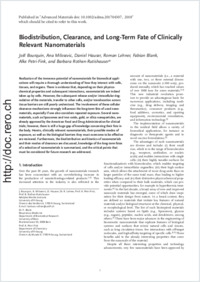Biodistribution, clearance, and long‐term fate of clinically relevant nanomaterials
- Bourquin, Joël Adolphe Merkle Institute, University of Fribourg, Switzerland
- Milosevic, Ana Adolphe Merkle Institute, University of Fribourg, Switzerland
- Hauser, Daniel Adolphe Merkle Institute, University of Fribourg, Switzerland
- Lehner, Roman Adolphe Merkle Institute, University of Fribourg, Switzerland
- Blank, Fabian Respiratory Medicine, Department of Biomedical Research, University of Bern, Switzerland
- Petri-Fink, Alke Adolphe Merkle Institute, University of Fribourg, Switzerland - Department of Chemistry, University of Fribourg, Switzerland
- Rothen-Rutishauser, Barbara Adolphe Merkle Institute, University of Fribourg, Switzerland
-
01.02.2018
Published in:
- Advanced Materials. - 2018, vol. 30, no. 19, p. 1704307
English
Realization of the immense potential of nanomaterials for biomedical applications will require a thorough understanding of how they interact with cells, tissues, and organs. There is evidence that, depending on their physicochemical properties and subsequent interactions, nanomaterials are indeed taken up by cells. However, the subsequent release and/or intracellular degradation of the materials, transfer to other cells, and/or translocation across tissue barriers are still poorly understood. The involvement of these cellular clearance mechanisms strongly influences the long-term fate of used nanomaterials, especially if one also considers repeated exposure. Several nanomaterials, such as liposomes and iron oxide, gold, or silica nanoparticles, are already approved by the American Food and Drug Administration for clinical trials; however, there is still a huge gap of knowledge concerning their fate in the body. Herein, clinically relevant nanomaterials, their possible modes of exposure, as well as the biological barriers they must overcome to be effective are reviewed. Furthermore, the biodistribution and kinetics of nanomaterials and their modes of clearance are discussed, knowledge of the long-term fates of a selection of nanomaterials is summarized, and the critical points that must be considered for future research are addressed.
- Faculty
- Faculté des sciences et de médecine
- Department
- Département de Chimie
- Language
-
- English
- Classification
- Biological sciences
- License
- License undefined
- Identifiers
-
- RERO DOC 306839
- DOI 10.1002/adma.201704307
- Persistent URL
- https://folia.unifr.ch/unifr/documents/306478
Statistics
Document views: 138
File downloads:
- fin_bcl.pdf: 431
